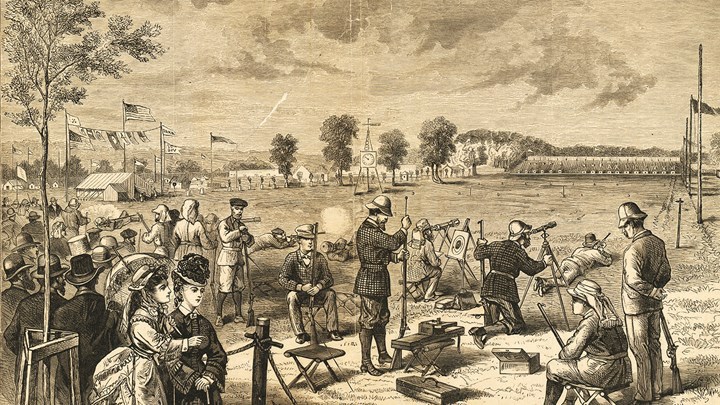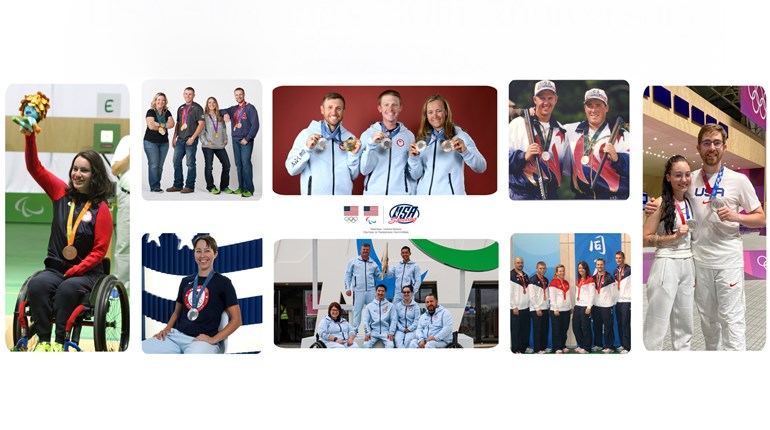
Above: This illustration, originally from Harper's Weekly, portrays the shooters and the viewing gallery at the 1876 Grand Centennial Championship—The "Palma" Match.
After its founding, one of the NRA's first orders of business was finding a suitable location for a shooting range and in 1872, a 70-acre tract of farmland along the Central and Northside Railroad on Long Island was acquired for $26,250. Through the NRA's Board of Directors, a bill entitled "An Act to Establish a Rifle Range and Promote Skill in Marksmanship" was drafted to secure public funds for the land purchase. Known as the "Judd Bill" for its sponsor, David Judd of the State Assembly, the request was approved. Railroad officials had bought the farm for its own expansion from the Creed family, but seized the opportunity to sell when it saw potential for increased rail traffic to and from the proposed range, which would sit just 12 miles outside of New York City. Almost immediately the area became known as Creedmoor, when Col. Henry G. Shaw of the NRA's first Range Committee commented that the land reminded him of moors in southern England.
Continuing its close association with the National Rifle Association of Great Britain, the NRA patterned its new range after England's renowned Wimbledon shooting grounds and adopted similar scoring procedures. The 12x6-foot iron targets of the day were even ordered overseas, since no U.S. manufacturer existed at the time. Range construction was extensive and included a daily ritual over a six-month period of several rail cars dumping fill dirt for safety embankments. Once Creedmoor's range with capacities out to 1,000 yards was complete, the first shots were fired in April of 1873, followed by a full schedule into the fall which culminated with the first Annual Matches of the NRA.
This October "fall prize meeting" featured 12 matches and opened with the "Judd Match," a five-round, any military rifle, 200-yard standing event in honor of the range bill's sponsor. Most of the matches were military competitions between regiments, highlighted by the State Match representing the championship of the New York State National Guard and featuring a Gatling gun as its top prize. But the 11th match of the contest was open to all, and allowed any rifle with seven rounds fired at 800 and 1,000 yards. Among those in attendance was the NRA's first affiliated group, The Amateur Rifle Club. With club organizer Wingate as its first president, the group emphasized long range and non-military target shooting, and set standards of marksmanship never before seen. The NRA's ambitions to jump start the state of military marksmanship in the United States were so successful that they quickly outgrew the boundaries imposed by state charter. Enthusiasm for state affiliations with the NRA program grew, and the quest for true national competitions was the next logical step.
Never was a national shooting coalition needed more than when the world's best shooters—the Irish Rifle Team—issued a challenge to the United States in 1874. The Irish had just on the prestigious Elcho Shield, emblematic of the rifle championship of the British Isles, the year prior. After years of English domination, Ireland won the event for the first time with a record score and was anxious to embellish its worldwide reputation. The Irish were led by Arthur B. Leech, namesake to the oldest NRA trophy competed for today. It was during this celebrated challenge event, billed as the "International Rifle Match" and held in conjunction with the NRA's Second Annual Matches at Creedmoor, that Leech presented the prestigious silver tankard to the U.S. team in the spirit of international friendship. And although the U.S. shooters, armed with specially made Remington and Sharps breechloaders chambered for the .44-90 cartridge, were decisive underdogs, they beat the Irish and their Rigby .45 caliber muzzleloaders, setting off waves of enthusiasm, pride and promise for the future of competitive rifle shooting. Analyses, breakdowns and comparisons of equipment, conditions and technique followed—changing the state and outlook of marksmanship in the United States for good.

Thus, a series of international shooting challenges and matches began, including a rematch with the Irish in 1875 at Ireland's Dollymount Range and the American Centennial (Palma) Match in 1876 at Creedmoor. The rematch with the Irish featured the presentation of the first Wimbledon Cup, which, like the Leech Cup, is still competed for today. By British rule, Americans could not compete for the Elcho Shield, so a separate 30-shot, 1,000-yard match was fired exclusively among U.S. shooters, with the historic Wimbledon Cup instituted as the annual award for the long-distance champion. The distinctive Palma Trophy, originally called the Centennial Trophy, was put in international competition by the U.S. as part of the country's 100-year celebration and remains one of the top international shooting honors today. Conditions for the first Palma match called for eight-man teams to fire 30 shots each at 800, 900 and 1,000 yards with no sighters. Five teams competed (Australia, Canada, Ireland, Scotland and the U.S.) in a match the New York Herald proclaimed as "fixing the date of the beginning of a period in the history of marksmanship which is destined to bring that art to the highest degree of perfection"
By 1878, U.S. shooters had four consecutive international victories in as many contests and were in the unusual position of not being able to lure foreign opposition onto Creedmoor turf. That same year, attempts to broaden the NRA's reach beyond New York were underway, as invitations to all rifle clubs and associations in the United States were extended for the Annual Matches at Creedmoor.
Teams from the regular Army fired in the NRA Annual Matches for the first time in 1878, primarily because the Secretary of War agreed to pay transportation costs for one team per Army division to compete in the International Military Match, a new event that year that bore the Hilton Trophy as its prize, joining the already popular Solider of Marathon Trophy (1875), which was awarded for inter-state military honors. Competing with .50 caliber Remington breechloaders, Army teams were decisively outscored by the National Guard forces. Just seven years into the NRA's existence, what initially began as an effort to further military competence with the rifle grew into an outright frenzy that produced some of the most coveted marksmanship awards still in competition. And not surprisingly, the NRA's Creedmoor Range quickly developed into a hub of U.S. shooting activity.
Creedmoor was novel in appearance and operation and featured a two-story building with piazzas, hotel, club rooms and post office. Such amenities were possible when the NRA leased an additional 25 acres from the railroad, which brought the total shooting expanse to 95 acres. The range, touted from the beginning as ideal due to its "flat as a billiard table" landscape, was enlarged to incorporate 10 more targets out to 400 yards, and included a running deer range donated by The Winchester Repeating Arms Company. Every attempt was made to create a festive, inclusive atmosphere and according to the NRA's Annual Report of 1878, "The initiation of ladies' day at Creedmoor ... afford(s) an opportunity for the female portion of the families of members to try their hands in the use of the rifle."
On the technical side, Creedmoor became the testing ground for improved arms and ammunition. An overall sense of experimentation led to a consistent pattern whereby standards and scores were challenged and pushed to new levels. It didn't take long for the name Creedmoor to become associated with competition-grade equipment, rifles and rules. And the fact that the word is still recognizable and used in present day competition, as in the case of "Creedmooring" when ties are decided via back count, testifies to this range's influence on the shooting game and verifies its legendary status.
See more: 10 Interesting Facts About The History Of The Shooting Sports

































